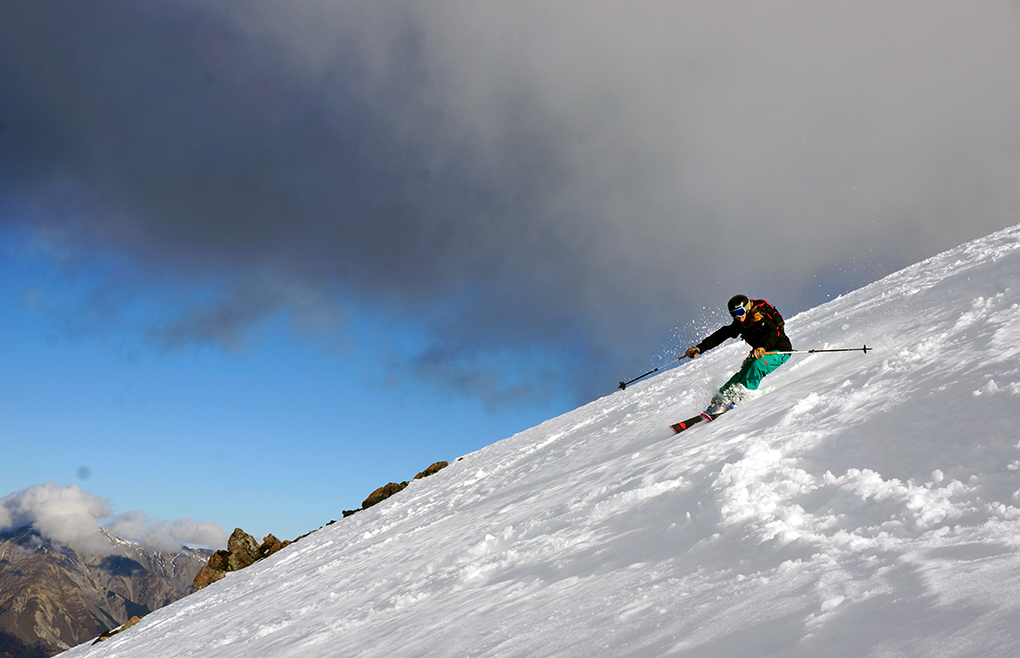Flex
Since several of the boots I’ve raced in had a stated flex of 120, I chose the RS 120 S.C. over the RS 110 S.C. because I wanted a boot for more aggressive skiing inbounds. One thing I should have considered, though, was how much I was training when I used to race. Spending weeks in the library writing a thesis this past spring was not the best strength conditioning program and, unsurprisingly, the boot’s 120 flex felt a little stiff for me.
This wasn’t a huge issue, and I ended up removing one of the rivets in the back of the boot, which softened the flex just enough. While the RS 120 S.C. felt pretty stiff on cold days, overall the boot was definitely manageable, even when I wasn’t at my strongest. I’d say that strong, aggressive female skiers who have been training should have no problem with the boot’s flex. If a 120 flex sounds a little too stiff, or you won’t have enough time to get those squats in early season, Lange RS 110 S.C. might be right up your alley.
Performance
I’ve almost always experienced achy feet the first few days in a boot, but never had any discomfort in the RS 120 S.C. The boot was extremely comfortable when I first tried it on, and remained comfortable on the mountain. I even found that I could buckle the boot as tight as I needed to for skiing without having to unbuckle them immediately when I got to the bottom of a run.
Even though I have a fairly high volume calf, after buckling the RS 120 S.C., I actually had a bit of extra space in the cuff. In order to eliminate some of this space, I had to buckle down the top two buckles quite a bit, which seemed to make the boots’ flex stiffer. The plastic would also firm up in colder temperatures, stiffening them up even more. I didn’t find this to be a huge issue in most temperatures, but it was definitely noticeable when things got cold as the boots would start to feel pretty unforgiving.
On the whole, though, I love the way the RS 120 S.C. feels while skiing. The design of the RS 120 S.C., with its slim, stiff liner, narrower last, and flex, translates into a precise and accurate feel on snow.

The Shiva Mx provides a decent amount energy through a turn, but it doesn’t feel quite as powerful as a race boot when ripping down groomers or powering through chop. The RS 120 S.C., on the other hand, is an incredibly supportive and lively boot that can be driven hard through all conditions and in all terrain with confidence. It provides a smooth, even flex that feels a lot like other race boots I’ve worn, without being quite as demanding.
In chop, as long as I applied strong pressure to the front of the boot, I never got tossed around. And on groomers, I could put a lot of energy into high angle carves and get a poppy, fun response without ever worrying about overpowering the boot.
I spent a lot of time hiking and bootpacking in the RS 120 S.C. up the ridge at Bridger Bowl, and around the club fields of New Zealand. The RS 120 S.C. is a fairly heavy boot, so unsurprisingly, it’s not the easiest to lug up steep boot packs lap after lap. Still, I didn’t feel like it slowed me down too much. The slicker, hard plastic race sole also didn’t provide the most traction on slippery slopes, but that’s to be expected.
Bottom Line
The Lange RS 120 S.C. is an extremely solid boot that strong, aggressive skiers who prefer a shorter cuff should really enjoy. Its slightly wider last makes it a more comfortable option for those who want a high-performance boot to ski hard inbounds, but would rather not squeeze into a plug race boot.
